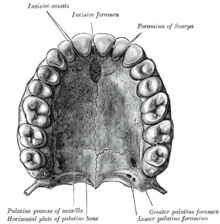The understanding and classification of the condition known today as cleft lip/cleft palate has changed over many years.[1]
Prior to the 1940s, the two main classifications were based on either the anatomical or the surgical perspectives.[1]
From the surgical perspective, Davis and Ritchie classified this condition based on the location of the cleft relative to the alveolar process: prealveolar (lip), postalveolar (palate), and alveolar process cleft.[1]
Brophy, a surgeon, proposed a list of 16 categories of cleft palate based on his understanding of anatomy.[1] Veau simplified Brophy's classification into four different morphological forms.[1]
In 1942, Fogh-Andersen classified cleft lip and cleft palate based on the incisive foramen, which is based on an embryological perspective: harelip, harelip with cleft palate, isolated cleft palate, and rare atypical cleft.[1]

 | This is a user sandbox of Arcmelodia. You can use it for testing or practicing edits. This is not the sandbox where you should draft your assigned article for a dashboard.wikiedu.org course. To find the right sandbox for your assignment, visit your Dashboard course page and follow the Sandbox Draft link for your assigned article in the My Articles section. |
- ^ a b c d e f Allori, Alexander C.; Mulliken, John B.; Meara, John G.; Shusterman, Stephen; Marcus, Jeffrey R. (2017-3). "Classification of Cleft Lip/Palate: Then and Now". The Cleft Palate-Craniofacial Journal. 54 (2): 175–188. doi:10.1597/14-080. ISSN 1055-6656.
{{cite journal}}: Check date values in:|date=(help)